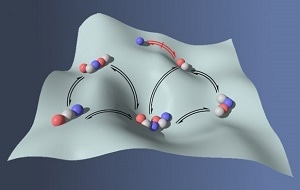Oct 5 2016
 This is a self-selection of peptide nanostructures. (Credit: Robert Mart - Cardiff University)
This is a self-selection of peptide nanostructures. (Credit: Robert Mart - Cardiff University)
Director of the CUNY Advanced Science Research Center (ASRC)’s Nanoscience Initiative and Professor of Chemistry at Hunter College, Rein Ulijn led a study that promotes the development of dynamically-evolving polymers capable of forming spontaneously by becoming accustomed to their environment.
This creates the potential for many product possibilities including food science, drug delivery, and cosmetics. The results of the study have been published in Nature Nanotechnology.
The peptides are strings of polymers made up of amino acids, and when they are allowed to constantly reorganize their sequences, they will gradually form into polymers that are well-suited to the environment instead of less favored structures.
This technique draws its inspiration from the principles of evolution, and allows Ulijn’s team to detect a range of never before seen peptide-based materials. Earlier studies in peptide nanotechnology was based on meticulous design or chance discoveries, the new research promotes impartial discovery by self-selection of optimized structures.
In our quest to find materials based on biology’s building blocks - but which are much simpler - it is difficult to rationally design these materials because there are very many possible permutations that could be explored.
Rein Ulijn, Director, ASRC
“Instead of designing rationally to improve materials, we’ve found a way to autonomously evolve,” said Charalampos Pappas, first author, and former CUNY ASRC postdoctoral researcher. “We achieve this by having components dynamically connect, rearrange and disconnect, resulting in the spontaneous selection and formation of the most stable self-assembling nanostructures.”
The paper, entitled “Dynamic peptide libraries for the discovery of supramolecular nanomaterials,” is an extension of Ulijn’s research of tunable peptide structures, which have revealed great potential in a number of commercial applications.
These include nanospheres which can be biodegradable and could possibly be applied in drug delivery applications, as well as nanofibers that form gel-phase materials, which can be used in a number of applications, including biodegradable plastics or cosmetics that can endure tough conditions.
However, the evolution-based peptide discovery technique is yet to cover the entire range of chemical functionalities available in natural materials and it is currently a time-consuming process.
These issues can potentially be overcome by automation and miniaturization of the process, which is the focus of current research.
Rein Ulijn, Director, ASRC
The Air Force Office of Scientific Research partially funded this research, and the study was conducted along with members of Ulijn’s research team at the University of Strathclyde, in Glasgow.
Cross-CUNY Collaboration Results in new Materials Discovery Approach
This study is one of the first realizations of a key goal envisioned with the formation of the CUNY ASRC: providing brilliant researchers from all over the CUNY system with an opportunity and instrumentation essential to perform advanced research and ensure the University becomes recognized as a key research institution.
The authors of the paper belong to a number of CUNY colleges, including Hunter College, Macaulay Honors College, and Bronx Community College. They conducted research at the ASRC.
The idea that within the CUNY system, talented students regardless of their level have an opportunity to access the top-level instrumentation and facilities we have at the center is part of what drew me to work at the ASRC. This opportunity for students from throughout the CUNY system - at a variety of levels - working together in a team to tackle a challenging interdisciplinary research project… I am immensely proud that we have been able to achieve this within two years of joining the ASRC.
Rein Ulijn, Director, ASRC
CUNY has the status as the largest urban university system in the U.S and its concentration of colleges facilitates interdisciplinary, collaborative research that offers undergraduates a chance to be published in some of the leading scientific journals in the world.
“The investment by CUNY to ensure it retakes its place amongst the top-level research institutions in New York City is beginning to bear fruit,” Ulijn said. “Having a concentration of facilities and scientific insight in an environment where this group of talented researchers is given every opportunity to succeed—again, regardless of level—will ensure that CUNY generates top-level research outputs demonstrating very clearly that its students are making meaningful contributions.”